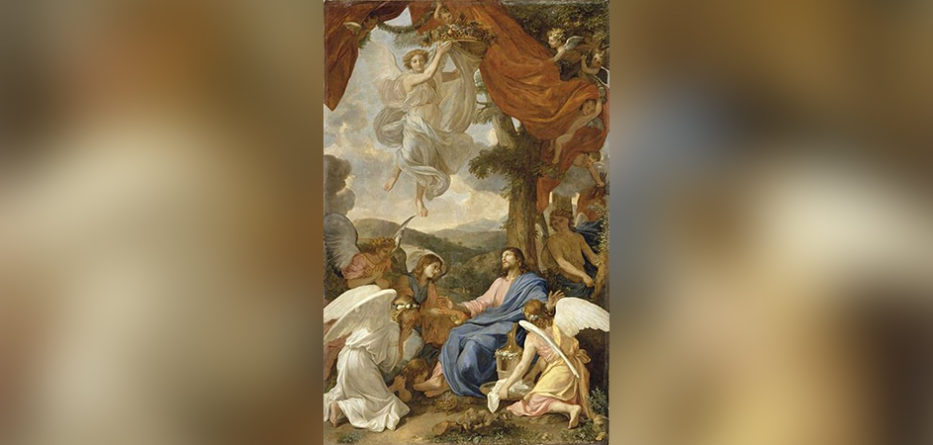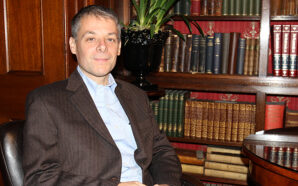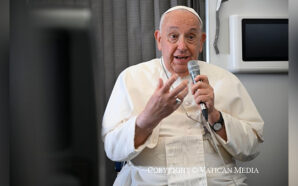First Sunday of Lent
Readings: Genesis 9:8-15; Psalm 24:4-9; 1 Peter 3:18-22; Mark 1:12-15
21 February 2021
Breaking open the word
Not too long ago, I heard about a young man who lost his sister before he was born, his mother at the age of eight, and his older brother and mentor at the age of 12. By the age of 21, his father, too, had passed away and he was living “underground”, hunted by a government that had already arrested and killed several of his friends.
Although today’s first reading promises that “there shall be no flood to destroy the earth again” (Gn 9:11), it seems like tragedy still comes in waves.
Why would the book of Genesis attribute to God the widescale destruction of the flood, only to then teach that he gives us the rainbow as a sign of his Covenant protection? And how can the liturgy pair this reading about the flood with the proclamation that God’s ways are love and truth (cf. Ps 25:10)? Does God really care about my little concerns, or am I just another piece on a cosmic chessboard?
This time last year, Christian musicians (including Wollongong’s own Bishop Brian!) united to sing a blessing over Australia. Similar movements occurred in over two dozen countries across six continents. The song chosen, written by Kari Jobe and others, repeats 35 times: “He is for you.” This powerful proclamation resonates both with the truth about who God is, and the truth that the human heart most needs to hear.
To love is to will the good of the other. So, the God whose very nature is love (1 Jn 4:16) can have no desires for us, no stance towards us, other than for our happiness—a happiness that “no thief can steal and no moth destroy” (Mt 6:19), both in this life and for all eternity.
But while on this earth, we are never able to see all sides of the story—after all, we can’t even see at one time more than three sides of a cube! And we must look to the second reading to discover the second half of the flood story.
“Christ himself, innocent though he was, died once for sins” (1 Pet 3:18)—the sins of all women and men, the cumulative consequences of humanity’s rejection of God. When Jesus descended into the place of the dead on Holy Saturday, those who refused to be saved by a wooden ark were offered salvation through a wooden cross. Those who were too caught up in life’s pleasures to listen to the words of Noah heard the Word of God himself who, “Went to preach to the spirits in prison” (1 Pet 3:19). And, as with all those who die, we pray that “through the resurrection of Jesus Christ, who has entered heaven and is at God’s right hand” (1 Pet 3:22), they now share his glory and sing his praise—a joy that knows no end.
St Catherine of Siena wrote, “You must believe in truth that whatever God gives or permits is for your salvation” (Letter, T354). And, just as the best rainbows are seen during sun-showers, so too are we best able to give glory to God when we let him lead us through suffering with trust in his providence and love.
It was after Jesus had endured the temptation in the wilderness that he was ready to proclaim the good news that “the kingdom of God is close at hand” (Mk 1:15). It was because of his experience of God’s truth and love even in the face of tragedy that the young man I mentioned, Pope St John Paul II, could proclaim to the whole world, “Do not be afraid!”— and have the whole world believe him.
Let us make acts of faith that whatever God sends our way today will be for our salvation, our eternal happiness.
Sr Susanna Edmunds OP
Reflecting on the Gospel through Art
Christ in the Desert, Served by Angels – Charles Le Brun (1619–1690)
Christ in the Desert, Served by Angels (c. 1653).Canvas, 390 × 254 cm. Louvre, Paris. Public Domain.
Every year on the first Sunday of Lent, the Gospel we hear is that of Jesus’ temptation in the wilderness. St Mark sums up his account in three short verses. Following his Baptism, Jesus is “driven” into the wilderness, Mark tells us. We often hear of people “driven”—by ambition, lust, desperation. But what “drives” Jesus is the Holy Spirit. Jesus is thrown into the world we are thrown into. In the time God gives us after our Baptism (40 days, 40 months, 40 years), we have to struggle with two realities: we have been named sons and daughters of God, but we are also part of a sinful humanity! Like Jesus, we too will struggle both with angels and with wild beasts.
In his 40-day experience in the desert, Jesus acts out in person Israel’s experiences in the 40 years it took to reach the Promised Land following her rescue from Egypt. Jesus’ temptations did not end with the 40 days, just as Israel’s temptations did not end with the 40 years. St Luke makes it quite clear that Satan was frustrated by Jesus’ rejection of him, and he promises to return. He returns finally at Calvary and puts on the lips of the crowd what often is in our hearts: “Come down from the cross.” In other words, “Do what we want and we will believe in you.” It is probably the ultimate temptation.
Matthew and Luke tell us Jesus underwent three temptations; temptations basic to any human. There was, first of all, the temptation to materialism—to deny the spiritual dimension of our lives. Secondly, there was the temptation to power—it had made Israel forget she was God’s chosen people. She had wanted to be a nation like other nations and, indeed, to dominate the rest. Thirdly, there was the doubt which had made Israel lose trust in the goodness of God.
Our temptations are not over once we have been rescued at Baptism. Satan never sleeps. Like Jesus, we will be constantly tossed into the wilderness of struggle and grace, of success and failure. We need this Lenten retreat to discover afresh God’s goodness, that his love for us remains even in, and above all, the adversity around us. “Lead us not into temptation,” we pray each day in the Our Father—the temptation to think that he has abandoned us. It is not without good reason that faith is symbolised by an anchor.
In his monumental Jesus of Nazareth, Cardinal Joseph Ratzinger, later Pope Benedict XVI, underlines the significance of Jesus’ “retreat” in the desert before the onslaught of the devil. It is a time of interior recollection during which Jesus wrestles with the odds—his own will or his Father’s will? It will be repeated in the agony in the garden. It would seem, then, that this was an ongoing struggle throughout his public life. Here in the desert, “It is a descent into the perils besetting mankind, for there is no other way to lift up fallen humanity. Jesus was to enter into the drama of human existence, for that belongs to the core of his mission; he has to penetrate it completely down to its uttermost depths in order to find the lost sheep, to bear it on his shoulders, and to bring it home” (The Illustrated Edition, pp 51–52).
The letter to the Hebrews eloquently describes Jesus’ mission in identifying himself with sinful humanity. “It was fitting that God…. should, in bringing many sons to glory, make perfect through suffering the leader of their salvation. Since all the children share the same human nature, he too shared equally in it, so that by his death he could set aside him who held the power of death, namely the devil, and set free all those who had been held in slavery all their lives by the fear of death. It was essential that he should in this way be made completely like his brothers so that he could become a compassionate and trustworthy high priest for their relationship with God, able to expiate the sins of the people. In the suffering he himself passed through while being put to the test enables him to help others when they are being put to the test” (Heb 2:10, 14–18).
In the persons of Adam and Eve, mankind is tempted to deny God. They are driven from the Garden to “till the soil from which (they) had been taken” (Gn 3:23). “Accursed be the soil because of you! Painfully you will get your food from it as long as you live. It will yield you brambles and thistles, as you eat the produce of the land” (Gn 3:17–18).
I can see now what Charles Le Brun is trying to say in his unusual Christ in the Desert, Served by the Angels. Desert? By reversing the disobedience of Adam and Eve, Christ has taken mankind back to the beginning. He is the new Adam, Son of the new Eve. The desert, the very opposite image of a garden, has now become the setting for man’s reconciliation with God. The wild beasts, symbols of evil, have become man’s friends—“He was with the wild animals” (Mk 1:13)—as predicted by the prophet Isaiah. “The wolf lives with the lamb, the panther lies down with the kid, calf and lion cub feed together” (Is 11:6). And Le Brun would have had before him the promise of Psalm 91: “To you has he commanded his angels, to keep you in all your ways.” There has been a return to paradise. Born in 1619, the son of a sculptor, Le Brun’s talent was noted in early age. He studied the frescoes at Fontainebleau, the royal hunting lodge outside Paris, and the paintings of the royal collections. His first important commission came from Cardinal Richelieu for three paintings for what is now the Palais-Royal. Wishing to perfect his education, he went to Rome in 1642 to study Raphael. Back in France, he was entrusted in 1661 with his largest project, the decoration of the Palace of Versailles. This would occupy him for the rest of his life. By 1664, he had become the painter to the king. Christ in the Desert now hangs in the Louvre. It was originally commissioned by the Carmelite Order.
Mgr Graham Schmitzer
Sr Susanna Edmunds OP grew up participating in Holy Mass and youth groups in the Diocese of Broken Bay where she received a love for Sacred Scripture and evangelisation. While studying engineering at the University of Sydney, she discovered the beauty of Eucharistic Adoration, regular Confession and faith-filled friendships through the Catholic student society and chaplaincy. World Youth Day 2008 brought Pope Benedict XVI and several hundred thousand pilgrims to Sydney’s shores, along with many religious congregations. Supported by friends and family, Sr Susanna discerned an invitation from the Lord to belong to him with an undivided heart. She joined the Dominican Sisters of St Cecilia in 2010, moving to Nashville TN, USA, where the community’s motherhouse is located. After completing further studies in philosophy, theology and secondary education, Sr Susanna began teaching in 2015. She made her final profession as a religious in 2017, and since 2018 has been teaching high school religion at Trinity Catholic College in Auburn, NSW. The sisters teach at four schools across Sydney and Melbourne, as well as assisting with young adult catechesis, women’s retreats and vocation discernment.
Monsignor Graham Schmitzer recently retired as the parish priest at Immaculate Conception Parish in Unanderra, NSW. He was ordained in 1969 and has served in many parishes in the Diocese of Wollongong. He was also chancellor and secretary to Bishop William Murray for 13 years. He grew up in Port Macquarie and was educated by the Sisters of St Joseph of Lochinvar. For two years, he worked for the Department of Attorney General and Justice before entering St Columba’s College, Springwood, in 1962. Fr Graham loves travelling and has visited many of the major art galleries in Europe.
With thanks to the Diocese of Wollongong, who have supplied these weekly Lenten 2021 reflections from their publication, Comfort – Lenten Program 2021.








